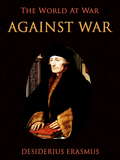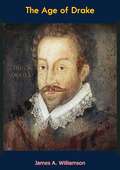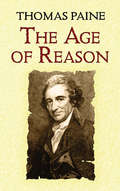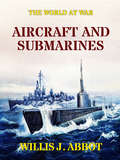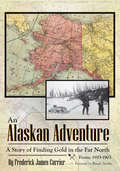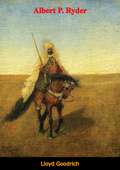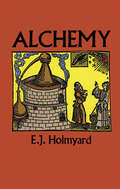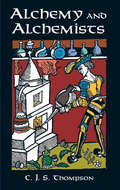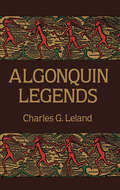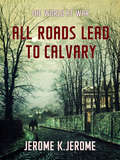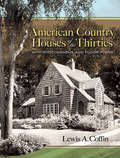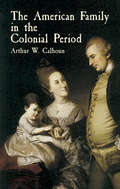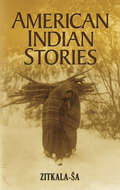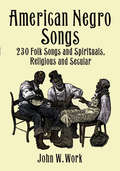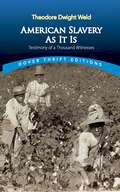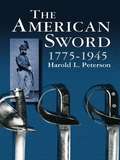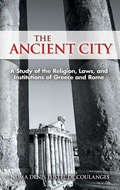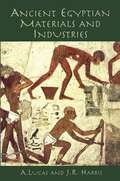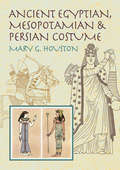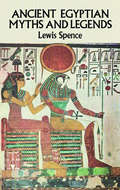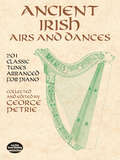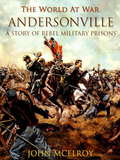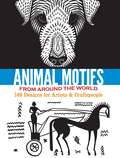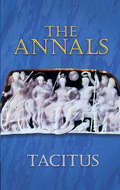- Table View
- List View
Against War (The World At War)
by Desiderius ErasmusA classic anti-war essay from the mid-1500s. Erasmus gives elegant arguments against war from both religious (Christian) and logical (economic, practical) points of view. He seems particularly alarmed and confused by Christians fighting wars with Christians. The problem, of course, is that people waging war only consider religious or logical reasons when they are looking for excuses to wage war.
The Age of Drake
by James WilliamsonTHE STORY OF THE GREATEST AGE IN ENGLISH SEA HISTORY“He was himself the leading authority in our generation on Tudor sea-history, the successor to Sir Julian Corbett in the last. He corrects Corbett’s want of perspective and gives us a proportioned and well-balanced account of the whole story. It is, in fact, much the best book on the greatest age in our sea history…. It is written with that spirit, that freshness and enthusiasm which seem always to go with a love of the sea. On almost every aspect of his subject, Dr. Williamson has something new to say or new information to bring forward. His expert knowledge of navigation and Tudor geography illuminate the book throughout.”—A. L. Rowse, The Spectator
The Age of Reason: Being An Investigation Of True And Fabulous Theology
by Thomas Paine Moncure Daniel Conway"Of all the tyrannies that affect mankind, tyranny in religion is the worst," declared Thomas Paine, adding, "every other species of tyranny is limited to the world we live in; but this attempts to stride beyond the grave, and seeks to pursue us into eternity." Paine's years of study and reflection on the role of religion in society culminated with his final work, The Age of Reason. This coolly reasoned polemic influenced religious thinking throughout the world at the dawn of the nineteenth century, and its resonance remains undiminished by time. The selfsame humanist and egalitarian views that made Paine a popular figure of the American Revolution brought him into frequent conflict with political authorities. Parts of The Age of Reason were written in a French jail, where Paine was confined for his opposition to the execution of Louis XVI. An atack on revealed religion from the deist point of view — embodied by Paine's credo, "I believe in one God, and no more" — this work undertakes a hitherto unheard-of approach to Bible study. Its critical and objective examination of Old and New Testatments cites nemerous contradictions as evidence against literal interpretations of the text. Well articulated and eminently readable, The Age of Reason is a classic of free thought.
Aircraft and Submarines: The Story Of The Invention, Development, And Present-day Uses Of War's Newest Weapons (classic Reprint) (The World At War)
by Willis J. Abbot(Excerpt) "Not since gunpowder was first employed in warfare has so revolutionary a contribution to the science of slaughtering men been made as by the perfection of aircraft and submarines. The former have had their first employment in this world-wide war of the nations. The latter, though in the experimental stage as far back as the American Revolution, have in this bitter contest been for the first time brought to so practical a stage of development as to exert a really appreciable influence on the outcome of the struggle."
An Alaskan Adventure: A Story of Finding Gold in the Far North From: 1893-1903
by Frederick James CurrierAs the descendant of early miners, a grandfather who prospected for gold in the Fairbanks area in 1908 and a father who mined from the 1920s through the early 1940s, my interest and fascination with Frederick Currier's manuscript was easily spiked. Currier's quest for gold from 1893 into the 1900s was an admirable pursuit. His account of prospecting ventures in 1898 on the Chena River near Fairbanks is spellbinding, especially in his use of a sternwheeler and his building of cabins as he prospected toward the headwaters. I have great admiration for the early gold prospectors like Frederick Currier since I have sunk a couple of shafts to bedrock with a windlass and know the effort and determination required. The power of a few nuggets can change a person's direction in life. Currier's, An Alaskan Adventure, is well worth reading—more than once.
Albert P. Ryder (The Great American Artists Series)
by Lloyd GoodrichAlbert Pinkham Ryder, along with Winslow Homer and Thomas Eakins, is recognized as one of the great “ancestors” of American painting, although he was largely unknown in his own time. Twentieth-century taste discovered him and his mystical pictures have had a profound effect on modern abstract art.Lloyd Goodrich is Director of the Whitney Museum of American Art under whose auspices his definitive biography of Thomas Eakins was published in 1933. For many years Mr. Goodrich has been carrying on research in the life and work of Albert P. Ryder, in preparation for a definitive biography. Since Ryder’s work has been widely forged, with the forgeries outnumbering the genuine pictures about eight to one, this study has involved examination of hundreds of paintings, using x-rays and other scientific methods. The present volume, originally published in 1959, has the advantage of these years of thorough study.
An Album of Maya Architecture (Native American)
by Tatiana ProskouriakoffMagnificent guide presents 36 sites from Central America and southern Mexico as they appeared more than a thousand years ago: Temple of the Cross, Palenque; Acropolis and Maya sweat bath, Piedras Negras; Red House and north terrace at Chichén Itzá; more. Each illustration features text of archeological finds and line drawing of remains. 95 illustrations.
Alchemy (Dover Books on Engineering)
by E. J. HolmyardAlchemy is thought to have originated over 2000 years ago in Hellenic Egypt, the result of three converging streams: Greek philosophy, Egyptian technology and the mysticism of Middle Eastern religions. Its heyday was from about 800 A.D. to the middle of the seventeenth century, and its practitioners ranged from kings, popes, and emperors to minor clergy, parish clerks, smiths, dyers, and tinkers. Even such accomplished men as Roger Bacon, Thomas Aquinas, Sir Thomas Browne and Isaac Newton took an interest in alchemical matters.In its search for the "Philosopher's Stone" that would transmute base metals into silver and gold, alchemy took on many philosophical, religious and mystical overtones. These and many other facets of alchemy are explored with enormous insight and erudition in this classic work. E. J. Holmyard, a noted scholar in the field, begins with the alchemists of ancient Greece and China and goes on to discuss alchemical apparatus, Islamic and early Western alchemy; signs, symbols, and secret terms; Paracelsus; English, Scottish and French alchemists; Helvetius, Price, and Semler, and much more.Ranging over two millennia of alchemical history, Mr. Holmyard shows how, like astrology and witchcraft, alchemy was an integral part of the pre-scientific moral order, arousing the cupidity of princes, the blind fear of mobs and the intellectual curiosity of learned men. Eventually, however, with the advent and ascension of the scientific method, the hopes and ideas of the alchemists faded to the status of "pseudo-science." That transformation, as well as alchemy's undeniable role as a precursor of modern chemistry, are brilliantly illuminated in this book. Students of alchemy, chemistry, the history of science, and the occult, plus anyone interested in the origin and evolution of one of mankind's most enduring and influential myths, will want to have a copy of this masterly study.
Alchemy and Alchemists
by C. J. ThompsonAlchemy, whose beginnings — possibly in Egypt, Babylon, India, or China — are ancient and obscure, remained undocumented until about 2500 BC. Although it may have originated with metallurgy, the practice rapidly developed an association with magic, pharmacy, and astrology. In this richly illustrated and amply researched study, a noted expert traces the long history of alchemy, from its murky start to modern times. Hermes Trismegistus and other famous alchemists appear here, along with discussions of the craft's associations with chicanery (as memorably portrayed in Ben Jonson's 1610 comedy, The Alchemist), and its role in the secret society of Rosicrucians. Additional topics include the alchemist's laboratory and equipment, alchemical symbols and secret alphabets, noteworthy manuscripts, the influence of astrology, and more. Although regarded today as a pseudoscience, alchemy gave rise to scientific chemistry. This volume illustrates the ways in which efforts to transmute metals — such as the search for the ever-elusive philosopher's stone — stimulated experimentation with hitherto untried substances, leading to improved knowledge of the materials vital to applied chemistry. Anyone intrigued by the origins and practices of this age-old and still-mysterious discipline, as well as those interested in the history of chemistry, will appreciate this concise, authoritative study.
Algonquin Legends (Native American Ser.)
by Charles G. LelandThis classic collection contains myths, legends, and folklore of the principal Wabanaki, or northeastern Algonquin Indians, i.e. the Passamaquoddies and Penobscots of Maine and the Micmacs of New Brunswick. Most of this material was gathered directly from Indian narrators by Charles G. Leland (1824-1903), a brilliant and gifted Philadelphia-born journalist, essayist, and folklorist.In compiling the work, Leland noted interesting affinities between the myths of the Northeastern tribes and those of the Eskimos, and striking similarities between the myths of the Algonquins and the Eddas, sagas and popular tales of Scandinavia. For example, may of the stories in this book deal with Glooskap, a divinity with strong resemblances to such Norse gods as Thor and Odin. We learn how Glooskap made man from an ash tree, named the animals, gave gifts to men, went to England and France and made America known to the Europeans, and performed many other curious deeds. Here too are the merry tales of Lox, the Mischief-maker, who bears a strong resemblance to Loki of Scandinavian mythology. Also included are the amazing adventures of Master Rabbit, the Chenoo legends, stories of At-o-sis the serpent, the story of the Three Strong Men, the Weewillmekq', tales of magic, and more.Myths and legends provide unique and authentic sources of knowledge about our deepest instincts and ways of interpreting the world and our place in it. This volume remains one of the most powerful and revealing studies of the Algonquin versions of such myths, a thorough, comprehensive collection that will prove invaluable to any student of American Indian culture or myth, folklore, and religion. General readers will also find these tales highly readable and delightfully entertaining.
All Roads Lead to Calvary (The World At War)
by Jerome K. JeromeThe novel "All Roads Lead to Cavalry" offers an irreverent take on the social forces at play in England in the period leading up to and just following the outbreak of World War I. If you're interested in history but often find yourself bored by historical fiction, this funny, one-of-a-kind novel is for you. (Google)
American Country Houses of the Thirties: With Photographs and Floor Plans
by Lewis A. CoffinAbout 1912, a renaissance of interest in early American architecture occurred that claimed the attention of a broad cross-section of the culture. It was demonstrated not only by being a popular topic in books and magazines, but also by the public's passion for collecting American antique furniture, and by students and architects traveling through different regions of the nation and photographing the most notable architectural examples. In the 1930s, the classic constructions from this earlier time mingled with the new materials and efficient designs, and the great American country house was born. This treasury showcases some of the finest American country houses produced during that unusually fruitful period. Culled from many of the best architectural firms of the time, the volume includes numerous detailed floor plans, lively sketches, and breathtaking photographs of exteriors and interiors. From simple cottages to functional family homes to sprawling estates, a wide variety of styles is represented. Celebrating the stately form, quiet technique, and balance and simplicity that is at the heart of every well-built American country house, anyone interested in history, art, and architecture will find in this collection an inspiring vision.
The American Family in the Colonial Period
by Arthur W. CalhounFirst published in the early 20th century, this book contributed significantly to an understanding of the forces at work in the evolution of family institutions in the United States. The first of a three-volume series, the text describes the American family as a product primarily of European folkways, economic transition to modern capitalism, and its distinctive environment — a virgin continent. Exhaustive in its use of primary and secondary sources, The American Family in the Colonial Period will be invaluable to students of early American history and of interest to all who enjoy reading about America's past and its early settlers.
American Indian Stories (Native American)
by Zitkala-SaBorn on South Dakota's Yankton Reservation in 1876, Zitkala-Sa felt "as free as the wind that blew my hair, and no less spirited than a bounding deer." At the age of 8, she traded her freedom for the iron discipline of a Quaker boarding school. Forever afterward, the Lakota Sioux author struggled to find a balance between Indian and white society. These autobiographical essays, short stories, and political writings offer her poignant reflections on being stranded between two worlds. Zitkala-Sa, who attended and taught at the Carlisle Indian Industrial School in Pennsylvania, was a founder of the National Council of American Indians and among the first Native Americans to record tribal legends and oral traditions. This collection opens with her reminiscences of the reservation, her schooling at an institution determined to "civilize" Indians, and her experiences as a teacher. Zitkala-Sa also recounts tales rooted in Sioux traditions, including "A Warrior's Daughter," in which a courageous woman risks everything for her husband-to-be; "The Trial Path," an account of tribal justice after a murder; and "The Sioux," in which a son must kill twice to save his father from starvation. The book concludes with incisive observations on government mistreatment of Indians and a call for the complete enfranchisement of Native Americans into mainstream society.
American Negro Songs: 230 Folk Songs and Spirituals, Religious and Secular
by John W. WorkFrom joyous gospel to deeply felt blues, this wonderful collection contains vintage songs sung and played through the years by black Americans — at work, in church, and for pure entertainment. Included are spirituals, blues, work songs, and a variety of social and dance songs.This important volume was originally compiled in 1940 by Dr. John W. Work, the noted musicologist affiliated with Fisk University and the celebrated Fisk Jubilee Singers. In it, he discusses the origins and history of black American folk music, the influence of slavery and African cultures, and the lyric significance of such much-loved songs as "Swing Low, Sweet Chariot," Steal Away to Jesus," "Lord, I Want to Be a Christian," and "John Henry." These informative notes lead up to the heart of the book: the complete words and music for 230 religious and secular songs, including "Study War No More," "Keep Me from Sinking Down," "You May Bury Me in the East," "Rock of Ages," "Go Tell It on the Mountain," and many others.This is an indispensable treasury of music for singers, musicians and all readers seeking a comprehensive sourcebook of black American folk music. It will be equally welcomed at parties, family get-togethers, sing-alongs, church events, and other gatherings where people want to play and sing these classic folk songs that are an integral part of American musical history.
American Slavery As It Is: Selections from the Testimony of a Thousand Witnesses (Dover Thrift Editions)
by Theodore Dwight WeldThe stories of hundreds of African-Americans who lived in bondage are preserved in this powerful 1839 chronicle. Compiled by a prominent abolitionist, the accounts include personal narratives from freed slaves as well as testimonials from active and former slave owners, presenting a condemnation of slavery from both those who experienced it and those who perpetuated it. Detailing the overall conditions of slaves across multiple states and several years, the book includes information on their diet, clothing, housing, and working hours as well as their punishments and suffering.Connecticut farmer-turned-abolitionist Theodore Dwight Weld (1803–1895) was a central leader of the American Anti-Slavery Society and traveled the country lecturing against slavery. Weld took great pains to document the trustworthiness of contributors to American Slavery so that there could be no doubt as to its authenticity. A major influence on Harriet Beecher Stowe's Uncle Tom's Cabin, the book sold 100,000 copies in its first year of publication and remains a valuable historical testament. This edited selection presents these powerful first-person accounts to a new generation.
The American Sword 1775-1945
by Harold L. PetersonThe first book devoted exclusively to the subject, this invaluable volume will aid collectors, curators, historians. Enhanced with more than 400 illustrations from rare documents, the book classifies and describes all major types of swords worn by the U.S. armed forces, cadets, and diplomats since the American Revolution to the end of World War II.
The Ancient City: A Study of the Religion, Laws, and Institutions of Greece and Rome
by Numa Denis Fustel de Coulanges Willard SmallWith this influential study, French historian Numa Denis Fustel de Coulanges initiated a new approach to Greek and Roman city organization. Fustel de Coulanges' 1864 masterpiece, La Cité antique, drew upon physical evidence as well as ancient documents rather than the usual post-Classical histories. The result is a fresh, accurate, and detailed portrait of the religious, family, and civic life of Periclean Athens and Rome during the time of Cicero.This fascinating sociological account reveals the significance of kinship and the cult of the family hearth and ancestors to ancient Hellenic and Latin urban culture. It chronicles the rise of family-centered pagan belief systems, tracing their gradual decline to the spread of Christianity. Fustel cites ancient Indian and Hebrew texts as well as Greek and Roman sources. The ingenuity of his interpretations, along with his striking prose style, offer readers a vital and enduring historic survey.
Ancient Egyptian Materials and Industries (Egypt)
by J. Harris A. LucasThe majesty and splendor of ancient Egypt were largely the result of the remarkably advanced technological skills developed by its artisans and craftsmen. This fascinating, comprehensive, and detailed study of ancient Egyptian technology meticulously describes the extent to which these workers and other Egyptians developed and used the land's vast resources.First published in 1926 and later revised and enlarged, this monumental work has become a standard reference, unparalleled in any other branch of archaeology. This volume reprints the fourth edition, painstakingly revised in light of more recent research and archaeological evidence.Among the subjects examined in the thoroughly documented text are the wealth of materials and processes that were an integral part of Egyptian daily life: the use of animal products, building materials, cosmetics, perfumes, and incense; fibers, glazed ware, glass and its manufacture; metals and alloys, painting materials, pottery making, woodworking, precious and semi-precious stones; distillation of alcoholic beverages; materials used in the mummification process, and much more.Enormously erudite, with an abundance of detailed information, Ancient Egyptian Materialsand Industries is an essential reference, valuable to students of Egyptology and classical civilizations and of vital interest to anyone intrigued by the long and remarkable history of technological development.
Ancient Egyptian, Mesopotamian & Persian Costume
by Mary G. HoustonClothing was hardly a practical necessity in North Africa and what is today the Middle East. Often a luxury item in these warm, humid climates, it became more essential as people's lives improved socially and economically. But even then, the drapery was light and tended to accent the body's shape rather than conceal it. The first part of this profusely illustrated and scrupulously researched text examines the evolution in apparel worn by Egyptian royalty, priests, musicians, manual workers, the military, and foreigners (as depicted by Egyptian artists). Two additional sections consider clothing worn in ancient Mesopotamia and Persia, focusing largely on Sumerian, Babylonian, and Assyrian styles. Over 250 illustrations, drawn in the artistic style of the period, are accompanied by flat patterns showing the cut of the garment, thus enabling today's costumers to accurately reconstruct this apparel. A comprehensive archive that will not only be of immense value to fashion historians and students of costume design, this volume will also fascinate anyone interested in the development of artistic representation.
Ancient Egyptian Myths and Legends
by Lewis Spence"Let us walk in the gloom of the pyramids, in the cool shadows of ruined temples, aye, through the tortuous labyrinth of the Egyptian mind itself, trusting that by virtue of the light we carry we shall succeed in unravelling to some extent the age-long enigma of this mystic land." — from Chapter One.In this classic study, a noted mythologist made perhaps the first serious attempt to review the religious history of ancient Egypt in the light of the science of modern mythology. Instead of regarding Egyptian mythology and legend as unique, "classic" and inviolate, as did many Egyptologists, Spence saw Egyptian religious thought as part of world mythology, rooted in primitive conceptions common to mankind as a whole and related to those of many other cultures. In supporting this thesis, Spence offers an immensely erudite in-depth survey of the broad spectrum of Egyptian gods and goddesses, cults, and beliefs, as well as a concise review of Egyptian history, manners, customs, and archaeology.Animism, totemism, fetishism, creation myths, and other aspects of early religious beliefs are explored in an introductory chapter. The author then goes on to discuss the Egyptian priesthood, mysteries and temples, the cult of Osiris; Ra the Sun-God, Anubis, Horus, Thoth, and numerous other deities; the Book of the Dead, the birth of Hatshepsut, sacred trees, alchemy, the festival of Bast, Egyptian art, magic, and amulets, legends; and a host of other topics.Enhanced with over 50 photographs and illustrations, this book belongs in the library of any student of ancient Egypt or of early man's attempts, through mythology and legend, to give order, meaning, and purpose to his world.
Ancient Irish Airs and Dances: 201 Classic Tunes Arranged for Piano
by George PetrieFrom the tender "My heart's love is he" to the bitter "Hag, you've killed me," this extraordinary compilation of melodies ranks among the most important 19th-century collections of traditional Irish music. Out of print for many years, these selections have become extremely rare and sought-after items.
Andersonville A Story of Rebel Military Prisons (The World At War)
by John McElroyThis is the story of Andersonville. Considered one of the most horrific prisons in the Civil War
Animal Motifs from Around the World: 140 Designs for Artists & Craftspeople
by Doris RosenthalDrawn from the ancient art and artifacts of an international array of museum collections, this spectacular volume offers a unique selection of unusual animal motifs from Prussia, Egypt, Persia, China, Germany, Sweden, and other areas. The edgy designs possess a timeless appeal that makes them especially attractive to contemporary designers, tattoo artists, crafters, and others.
The Annals
by Tacitus Alfred John Church William Jackson Brodribb"The first writer in the world, without a single exception," declared Thomas Jefferson of Tacitus, proclaiming this book "a compound of history and morality of which we have no other example." The ancient historian wrote this vital chronicle of Imperial Rome during the great civilization's decline. It spans A.D. 14-68, painting incisive psychological portraits of the era's major figures.Tacitus held high offices in the Roman government, allowing him firsthand views of the emperors and the effects of their tyranny. His chronicle begins with the death of Augustus and relates the moral decline and rampant civil unrest during the reigns of Tiberius, Caligula, Claudius, and Nero. He also discusses in detail the period's many military campaigns. Masterful in his handling of dramatic narrative and trenchant in his discourse, Tacitus is the model historian. The Annals not only records the past but also re-creates it for modern readers.
